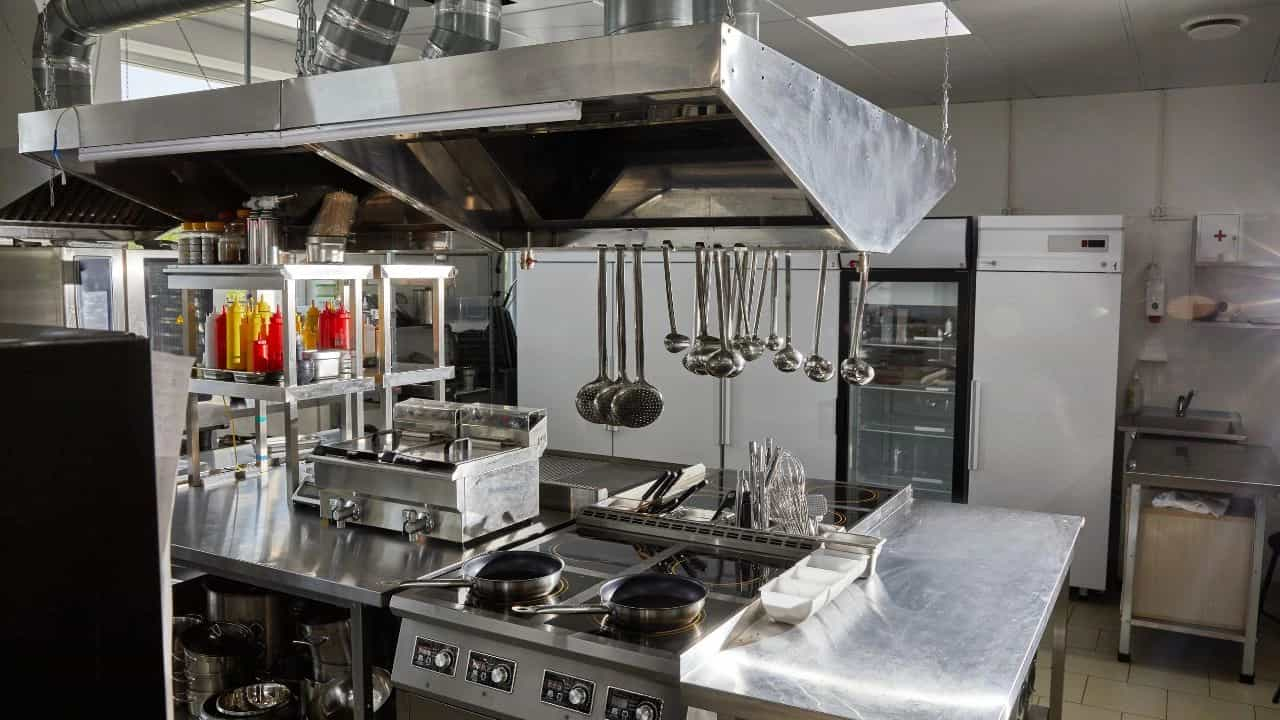A busy restaurant kitchen buzzes with activity on a Friday night. Pans sizzle, chefs chop veggies, and delicious aromas fill the air. Behind this culinary magic lies an unsung hero: a spotless, well-maintained kitchen. In food service, hygiene is everything, from food trucks to Michelin-starred restaurants.
Essential commercial kitchen cleaning tips help keep customers safe, protect your reputation, and ensure smooth operations. Let’s explore these tips and dive into why cleanliness matters in your commercial kitchen.
Commercial Kitchen Cleaning
The CDC reports that 50% of foodborne outbreaks stem from poor restaurant hygiene. This fact highlights the importance of proper kitchen maintenance.
Importance of Maintaining Cleanliness in Commercial Kitchens
A clean kitchen prevents fires caused by grease buildup on equipment. It also helps avoid foodborne illnesses that can harm customers and damage your reputation.
Regular cleaning protects your staff, too. Over 3 million food service workers have slip accidents yearly. These accidents cost the industry $2 billion annually.
Overview of Common Kitchen Contaminants
Commercial kitchens face various contaminants daily. These include bacteria, viruses, grease, and food debris. Proper hand hygiene is essential to prevent germ spread.
Wash hands with soap and warm water for at least 20 seconds. Use cleaning chemicals like bleach, degreasers, and sanitizers to fight contaminants effectively.
Legal and Health Regulations for Kitchen Hygiene
Following legal and health regulations is a must for restaurants. Create and stick to a cleaning schedule to maintain hygiene standards. Conduct deep cleaning monthly to tackle hard-to-reach areas.
Use warm water (at least 120°F) for effective cleaning to kill microorganisms. Proper cleaning ensures compliance and contributes to positive customer experiences.
| Cleaning Task | Frequency | Importance |
| Hand washing | Multiple times daily | Prevents germ spread |
| Surface sanitization | After each use | Reduces contamination risk |
| Floor cleaning | Daily | Prevents slip hazards |
| Deep cleaning | Monthly | Tackles hidden contaminants |
Daily Cleaning Routin
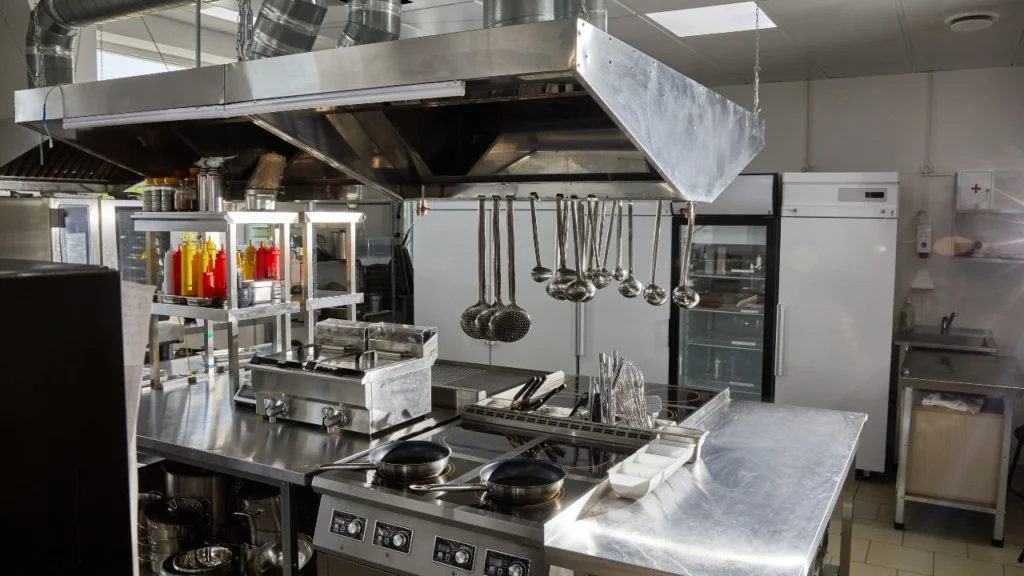
A clean commercial kitchen is vital for food safety and efficiency. A daily cleaning routine helps maintain high hygiene standards. Let’s explore key parts of an effective cleaning plan.
Checklist for Daily Cleaning Tasks
A daily cleaning checklist ensures consistent kitchen maintenance. Kitchen staff should focus on these tasks:
- Wipe down walls with splashes in back-of-house areas
- Change foil linings on ranges, grills, and flattops
- Wash and air-dry utensils, small wares, flatware, and glassware
- Refill soap dispensers and replace empty paper towel rolls
- Sanitize tables, clean seats and benches in front-of-house areas
- Clean and sanitize restroom surfaces
Recommended Cleaning Supplies and Equipment
Effective cleaning requires the right tools. Essential supplies include:
- Degreasers for heavy-duty cleaning
- Disinfectant sprays for sanitizing surfaces
- Microfiber cloths for efficient wiping
- Mops and buckets for floor cleaning
- Scrub brushes for tough stains
Tips for Efficient Surface Cleaning
Follow these practices for a clean commercial kitchen:
- Clean spills immediately to prevent slip hazards
- Use hot water and appropriate cleaning agents for different surfaces
- Start cleaning from top to bottom to avoid re-contamination
- Sanitize food contact surfaces frequently throughout the day
- Encourage frequent handwashing among kitchen staff
A thorough daily cleaning checklist and proper techniques maintain a hygienic kitchen. This ensures food safety and improves equipment lifespan. It also boosts overall efficiency in the commercial kitchen.
Deep Cleaning Schedule
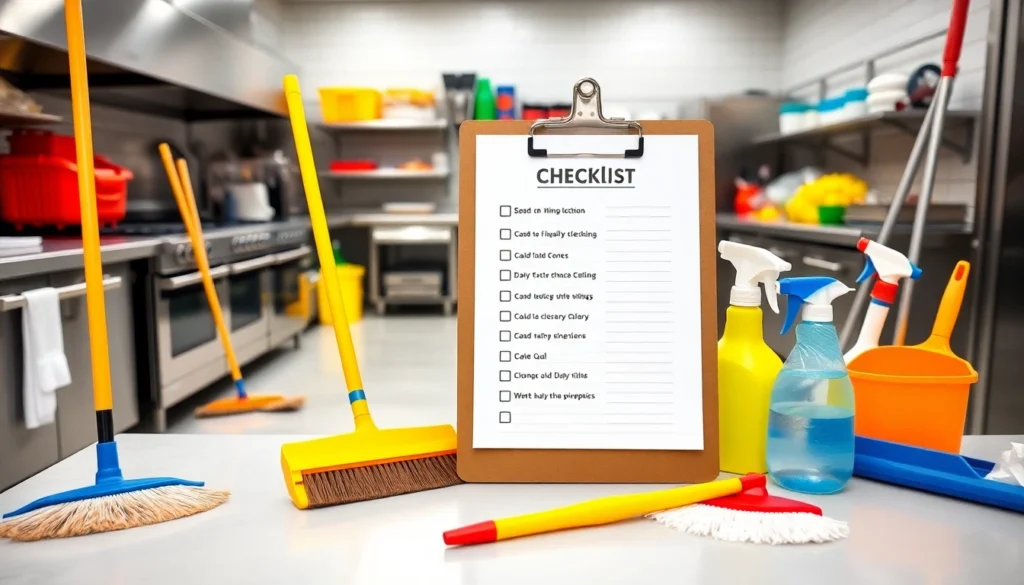
A solid deep cleaning plan is key for commercial kitchen upkeep. It boosts food safety and equipment life. It also keeps hygiene standards high.
Let’s look at the main parts of a good deep cleaning routine.
Frequency and Benefits of Deep Cleaning
Deep clean weekly or monthly, based on kitchen use. This kills germs and stops food-borne illnesses. Regular deep cleaning leads to better health scores.
It also results in good customer reviews. This can bring more repeat business.
Specific Areas Requiring Regular Deep Cleaning
Key areas needing frequent deep cleaning include:
- Ovens and fryers
- Vent hoods and filters
- Refrigerators and freezers
- Grease traps
- Walls and ceilings
Best Practices for Deep Cleaning
Follow these best practices for effective kitchen deep cleaning:
- Use appropriate cleaning chemicals for each surface
- Follow manufacturer instructions for equipment cleaning
- Ensure thorough sanitization of all surfaces
- Delegate tasks and create individual cleaning checklists
- Store cleaning supplies away from food preparation areas
A thorough deep cleaning plan keeps your kitchen safe and efficient. It also helps you follow rules and run smoothly.
Specialized Cleaning Techniques
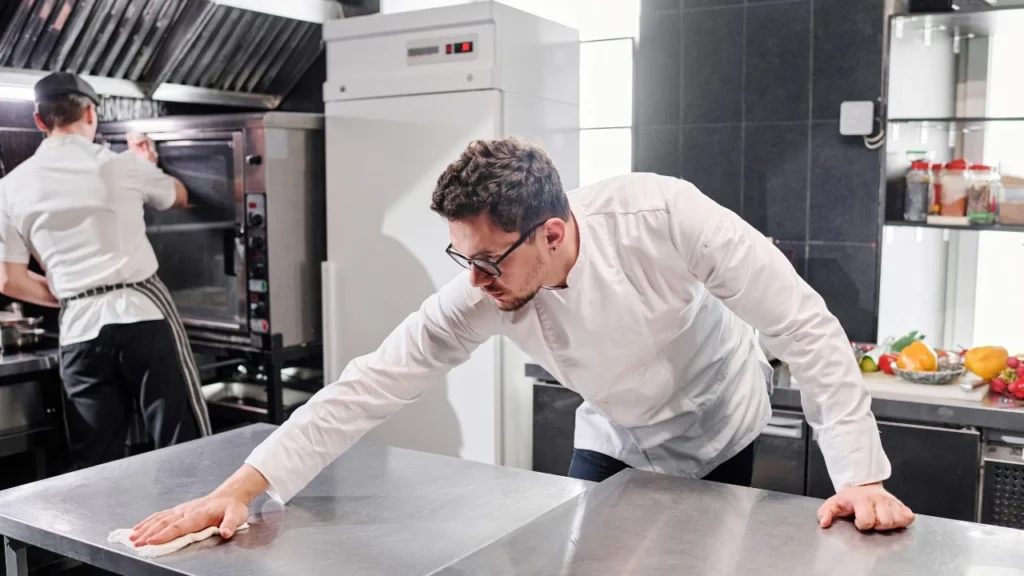
Clean commercial kitchen equipment is vital for food safety and customer satisfaction. A whopping 82% of consumers avoid restaurants with poor cleanliness ratings. Let’s explore effective sanitization methods for food prep areas and kitchen appliances.
Cleaning Kitchen Equipment and Appliances
Stainless steel surfaces need regular cleaning despite being bacteria-resistant. Always unplug electric appliances before cleaning and remove detachable parts.
Gas burners need special attention to prevent carbon deposits and gas waste. Regular maintenance ensures optimal performance and safety in the kitchen.
Sanitizing Food Preparation Areas
Food prep areas are hotspots for cross-contamination. Color-coded cleaning techniques can reduce contamination risks by 75%. Clean and sanitize between different food types to maintain hygiene.
Shockingly, 68% of foodborne illness outbreaks are linked to improper cleaning practices. Proper sanitization is key to preventing these issues.
| Equipment | Cleaning Frequency | Sanitization Method |
| Cutting Boards | After each use | Hot water and sanitizer |
| Ovens | Daily | Degrease and sanitize |
| Refrigerators | Weekly | Disinfect and wipe dry |
| Deep Fryers | Weekly | Oil filtration or replacement |
These specialized cleaning techniques can greatly improve kitchen hygiene. Regular deep cleaning by professionals reduces pest infestation risks by 90%. Prioritizing cleanliness ensures customer trust and loyalty.
Floor and Drain Maintenance
Clean floors and clear drains are vital for safe, hygienic commercial kitchens. Regular upkeep prevents hazards and ensures smooth operations.
Techniques for Floor Cleaning and Sanitization
Commercial kitchen floors collect dirt from spills, grease, and foot traffic. Daily sweeping and mopping are crucial. Weekly deep cleaning is needed for thorough sanitation.
Use special degreasers and scrubbers to remove tough grime. This ensures a truly clean kitchen floor.
Preventing Slip and Trip Hazards
To reduce floor hazards, try these strategies:
- Use non-slip mats in high-traffic areas
- Clean spills immediately
- Enforce proper footwear policies
- Maintain floor surfaces regularly
Keeping Drains Clear and Odor-Free
Good drain care controls odors and prevents backups. Most issues come from FOG (Fat, Oil, and Grease) buildup.
Install grease traps to separate oils from water. This prevents pipe clogs. Clean P-traps under sinks to stop sewage smells.
Try weekly foaming drain line services for effective maintenance. They use bioactive foam to clean drains without harsh chemicals.
Managing Waste and Pest Control
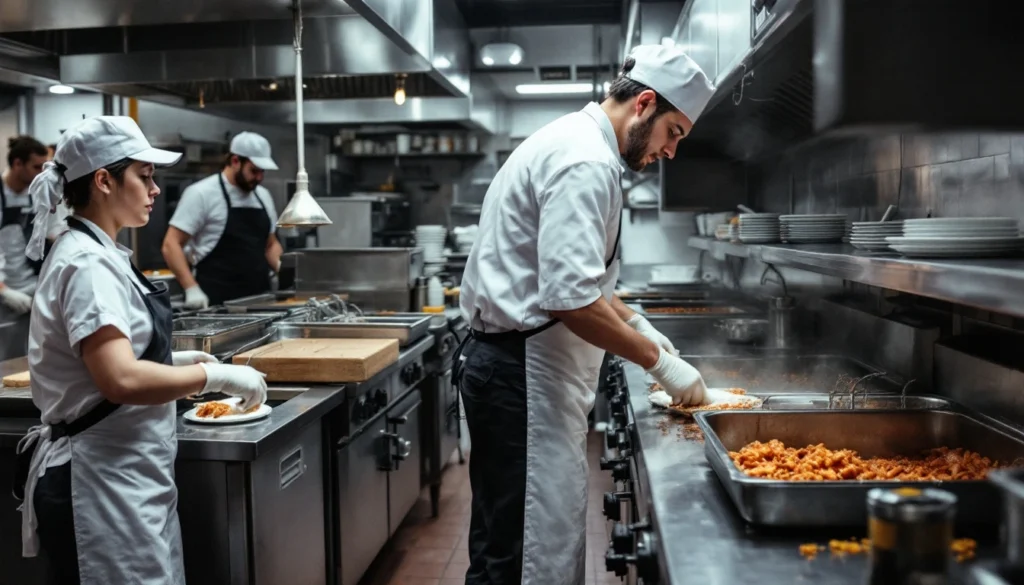
Clean kitchens protect your reputation and profits. They also meet health rules. Good waste disposal and pest control are key in
Proper Waste Disposal Methods
Restaurants deal with trash daily. Remove food waste often. Clean and sanitize bins to avoid smells and pests.
Use recycling to cut down on waste. This helps manage your overall trash volume.
Preventative Measures Against Pests
Stop pests before they start. Seal entry points and store food right. Keep everything clean.
Check food storage often. Catch problems early. Did you know a housefly can carry millions of germs?
Integrated Pest Management Strategies
Integrated Pest Management (IPM) is a smart way to control pests. It mixes prevention, checking, and targeted treatments.
IPM uses fewer chemicals but still works well. Team up with pest experts to make a solid plan.
- Sweep and vacuum under tables and chairs regularly
- Clean up spills immediately, even water
- Maintain cleanliness in parking lots and dumpster areas
- Eliminate standing water to prevent nuisance pests
These steps create a safer space for staff and guests. Good waste and pest control help your restaurant thrive.
Training and Staff Involvement
Staff training is vital for a clean, efficient commercial kitchen. It boosts employee retention and customer satisfaction. Proper hygiene practices are key to success.
Importance of Staff Training on Hygiene Practices
Effective hygiene training reduces kitchen accidents by 30%. It also lowers the risk of foodborne illnesses. The FDA Food Code guides sanitary conditions in kitchens.
Staff must understand and follow these standards. This knowledge helps maintain a safe, clean environment for all.
Creating Cleaning Schedules and Task Assignments
Cleaning schedules ensure consistent cleanliness in kitchens. Digital tools like Manifestly Checklists help track tasks across teams. This approach boosts kitchen efficiency by 20%.
It also cuts down on errors and food waste by 15%. Regular cleaning becomes a natural part of staff routines.
Encouraging Accountability and Hygiene Compliance
Regular feedback can boost productivity by 20%. Mentorship programs improve employee satisfaction by 35%. Recognizing achievements increases employee morale by 20%.
These strategies create a culture of accountability. They also ensure staff follow hygiene rules consistently.
| Training Method | Impact |
| Hands-On Training | 30% increase in employee engagement |
| Cross-Training | 20% increase in kitchen efficiency |
| Simulated Scenarios | 40% reduction in emergency response time |
Thorough staff training and detailed cleaning schedules are crucial. They help maintain high hygiene standards. This ensures customer safety and restaurant success.
Sustainable Cleaning Practices

Eco-friendly cleaning methods are crucial for commercial kitchens. These practices reduce environmental impact and boost public image. Businesses can benefit from adopting sustainable cleaning approaches.
Using Eco-Friendly Cleaning Products
Eco-friendly cleaning solutions are gaining popularity across industries. These products maintain high hygiene standards while minimizing ecological footprints. Green cleaning involves a comprehensive approach to reduce environmental impact.
Reducing Water and Energy Usage During Cleaning
Efficient cleaning techniques help save water and energy. Regular equipment maintenance ensures optimal function, reducing energy consumption. Proper ventilation helps dissipate harmful vapors naturally, cutting down on artificial air fresheners.
Implementing Recycling Practices in the Kitchen
Recycling is essential for sustainable kitchen practices. Staff training in environmental stewardship leads to better waste management. Simplifying spaces can increase cleaning efficiency, reducing time and resource needs.
- Use biodegradable cleaning products
- Implement water-saving techniques
- Set up recycling stations for different materials
- Train staff on proper recycling procedures
Sustainable practices help kitchens meet regulations and gain a competitive edge. Balancing effectiveness and ecological sensitivity is key. This approach meets cleaning needs while respecting our planet.
Conclusion
A clean commercial kitchen is crucial for food safety and efficiency. Regular cleaning routines and deep cleaning schedules are essential. These practices ensure a hygienic environment that meets health standards and promotes food safety.
Recap of Key Cleaning Tips
Daily tasks include cleaning equipment, utensils, and surfaces. Weekly and monthly schedules should address deeper cleaning needs. Invest in commercial-grade cleaning products and train staff properly.
Focus on combating grease buildup and maintaining stainless steel. This helps prevent contamination and keeps the kitchen running smoothly.
Long-term Benefits of a Clean Commercial Kitchen
A clean kitchen reduces equipment breakdowns and health risks. It ensures compliance with hygiene standards and improves food quality. Better health inspection scores enhance your restaurant’s reputation.
Encouraging a Culture of Cleanliness
Stress the importance of cleanliness to all staff members. Implement detailed cleaning schedules and conduct regular inspections. Maintain robust ventilation systems to support a clean environment.
Prioritizing cleanliness creates a safer, more efficient kitchen. This benefits both your staff and customers in the long run.
FAQ
What should be included in a daily cleaning routine for a commercial kitchen?
Daily cleaning should include wiping surfaces and sanitizing food prep areas. Cleaning appliances and mopping floors are also essential. Use a checklist for consistency and staff accountability.
Frequent hand washing and quick spill clean-up are crucial tasks. These habits help maintain a safe kitchen environment.
How often should deep cleaning be performed in a commercial kitchen?
Deep cleaning should occur weekly or monthly, depending on the area. Ovens, fryers, vent hoods, and refrigerators need regular deep cleaning. The frequency may vary based on usage and health code requirements.
What are some specialized cleaning techniques for kitchen equipment?
Ovens and grills need disassembly, soaking of parts, and thorough scrubbing. Deep fryers require regular oil filtering or replacement. Clean and sanitize prep areas between different food types.
Use appropriate cleaning solutions for various surfaces. Always follow proper sanitization procedures to ensure food safety.
How often should grease traps be maintained in a commercial kitchen?
Inspect grease traps weekly and clean them at least monthly. Regular maintenance prevents blockages and reduces odors. It also ensures compliance with local regulations.
High-volume kitchens may need more frequent cleaning. This keeps the grease traps working at their best.
How can we prevent slip and trip hazards in the kitchen?
Clean spills promptly, maintain floor mats and degrease floors regularly. Use proper degreasing techniques and specialized equipment to remove grease. Set up a system for quick spill response.
Ensure proper drainage to minimize wet floors. These steps help create a safer work environment.
Resources
https://cleanmethod.com/blog/how-to-properly-clean-a-commercial-kitchen
https://commercialcleaningcorp.com/best-way-to-clean-a-commercial-restaurant-kitchen
https://www.sunriseindustrial.com/5-effective-cleaning-tips-for-a-spotless-commercial-kitchen/
https://www.linkedin.com/pulse/how-clean-commercial-kitchen-step-by-step-guide-mxh8e


